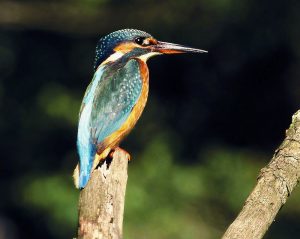Winter Wildlife Watching by Andrew Cooper
Winter is a great time to watch wildlife and walking into the wind can be especially fruitful. Many birds and mammals are so busy finding food they do not sense your approach. You can get quite close, but I never like to startle a creature. At this time of the year small birds conveniently gather in large flocks to forage the fields. On estuaries huge numbers gather on the mud and large ponds attract some of our most colourful birds. The advantage to the birdwatcher is that several species may be seen in a single view. And the occasional surprise visitor is a bonus.
So what can you do to enjoy our bird life even more? Binoculars! While the range, power and style can be a bit baffling, help is at hand. Go along to a local Wildlife Trust meeting and if you can, always try a pair of binoculars before buying them.
So far this winter has been memorable for many of the wrong reasons. Here in Devon it has been one of the wettest and warmest I can remember. Only in the last few days have we had our first frost. The steepness of the valley means that the lowest fields get swamped, but the run off can be a bit worrying. Flooded fields also prevent birds from finding food. But, there is a better way to enjoy your birdlife. Why get cold and wet battling the worst of the weather when you can let birds come to you? Increasing evidence is proving that regular feeding benefits both birds and us. Late winter is the ideal time to put out extra food on your bird table, visit a local bird hide or perhaps a good zoo. It always surprises me how many wild birds can be seen in such places. With a good pair of binoculars you can see more and really enjoy the detail.
Andrew Cooper
So what can you do to enjoy our bird life even more? Binoculars! While the range, power and style can be a bit baffling, help is at hand. Go along to a local Wildlife Trust meeting and if you can, always try a pair of binoculars before buying them.
So far this winter has been memorable for many of the wrong reasons. Here in Devon it has been one of the wettest and warmest I can remember. Only in the last few days have we had our first frost. The steepness of the valley means that the lowest fields get swamped, but the run off can be a bit worrying. Flooded fields also prevent birds from finding food. But, there is a better way to enjoy your birdlife. Why get cold and wet battling the worst of the weather when you can let birds come to you? Increasing evidence is proving that regular feeding benefits both birds and us. Late winter is the ideal time to put out extra food on your bird table, visit a local bird hide or perhaps a good zoo. It always surprises me how many wild birds can be seen in such places. With a good pair of binoculars you can see more and really enjoy the detail.
Andrew Cooper



